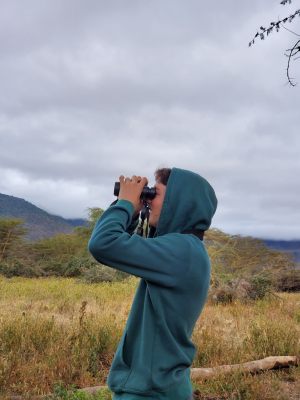
Day
1 10th July
When Moran invited me to join the
Segolis on a safari to Tanzania, I jumped at the opportunity. Eitan and
I have
visited Kruger and other parks numerous times, where we have always
been amazed
by the variety of animals we were privileged to see. But they were
usually
‘lonelies’ as our Tanzanian guide Njano was wont to call solitary
animals. I
wanted to see “lots of,” large numbers.

Despite the huge crowds at Ben Gurion
airport we went through fairly quickly and were happy to board the
Ethiopian
airlines plane, where the seats were surprisingly spacious. After
another long
wait at Addis Ababa we excitedly arrived at Kilimanjaro airport where we were met by our
guide Njano Amity Mbilinyi and piled into the safari jeep, driving to
Tarangire
National Park.
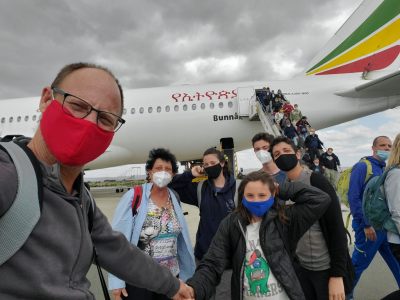

On the way we passed many villages,
reminding me of countless poor African villages. We were surprised by
the
number of young men lounging on motorbikes near the roads until we
learnt that
they, in addition to the tuk tuk taxis, were waiting to take people
home on
sandy roads that the buses couldn’t traverse.
Different kinds of acacia trees and baobabs, termite
mounds and dry grassland formed a
familiar landscape, remembered from various African safaris, among
them, Tsavo
in Kenya, Gorongosa in Mozambique and Namibia
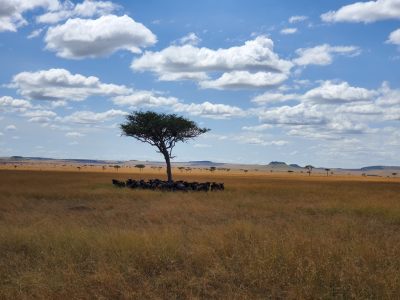
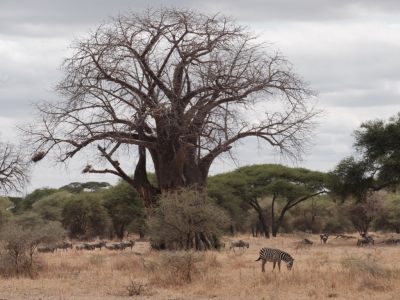
At a designated toilet
stop Lotem
made the acquaintance of a Vervet monkey. Everyone became excited to see mongooses racing in the
grass.
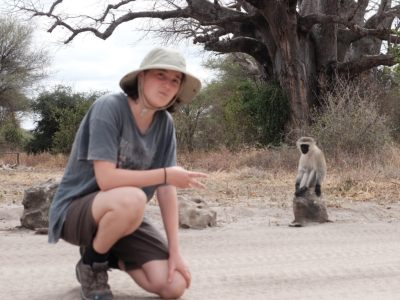
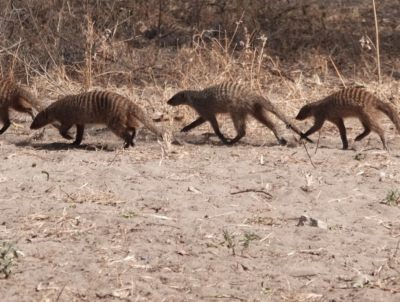
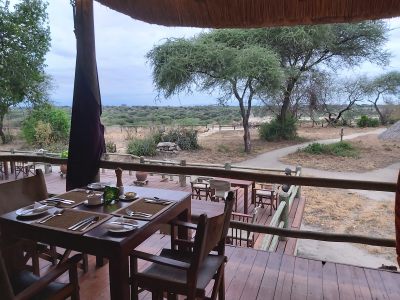
Day
2 11th July
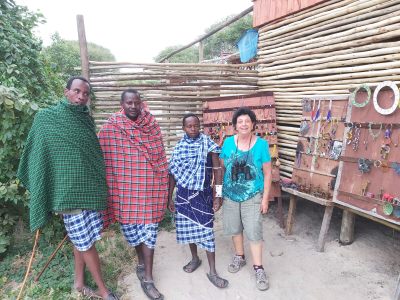
The next morning we were up early and after
a hearty breakfast we said kwaher, goodbye
to the staff, after posing for a photo.
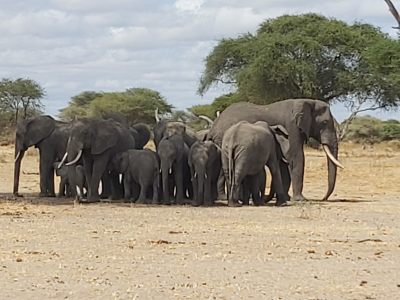
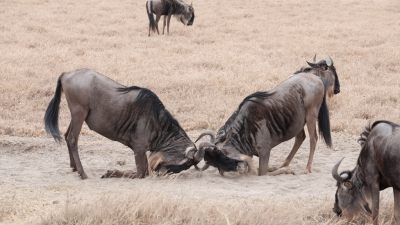

Njano, who has amazing knowledge of
animals and their behavior also has an uncanny ability to spot animals
both big
and small even while driving his jeep over the roughest terrain.
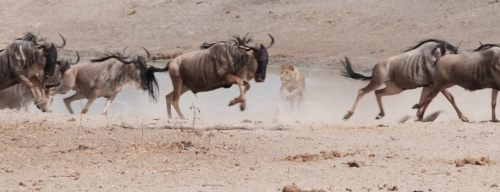 Our
first
important stop was by a waterhole. With the roof up, Njano showed us
where a lion
lay in wait. First a herd of elephants came to drink, mainly mothers
with their
babies and young males. The females, led by a matriarch, stay together
their
whole lives while the males leave when reaching adulthood. The herd
drank and
enjoyed the water. If they were aware of the lion they weren’t bothered
but
always made sure to keep the young within the herd. After they left and
congregated just outside the water hole a group of wildebeest (also known as gnus
because of the sound they
make) came
hesitantly to drink. The lion made its move but the gnus were quick to run
away. It wasn’t the lion’s
day as he also failed to catch buck or zebra that came to drink that
day.
Our
first
important stop was by a waterhole. With the roof up, Njano showed us
where a lion
lay in wait. First a herd of elephants came to drink, mainly mothers
with their
babies and young males. The females, led by a matriarch, stay together
their
whole lives while the males leave when reaching adulthood. The herd
drank and
enjoyed the water. If they were aware of the lion they weren’t bothered
but
always made sure to keep the young within the herd. After they left and
congregated just outside the water hole a group of wildebeest (also known as gnus
because of the sound they
make) came
hesitantly to drink. The lion made its move but the gnus were quick to run
away. It wasn’t the lion’s
day as he also failed to catch buck or zebra that came to drink that
day. 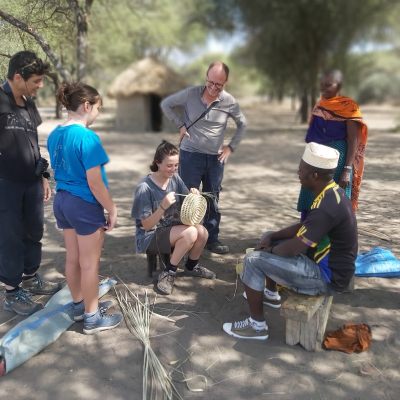
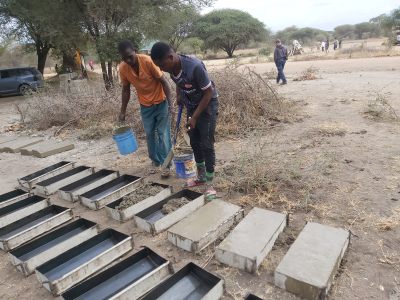

We ate our lunches packed in little brown paper bags at the Matete picnic site overlooking the Tarangire River. We were delighted to see the animals come to drink. In our packed lunch I enjoyed eating a delicious samosa. Eitan and I always try samosas, well remembering the delicious samosas from Durban and are invariably disappointed. But this samosa, from Tarangire Lodge was excellent. The Vervet monkeys are not afraid and often came to tables where people were eating and snatched away anything that was on the table.
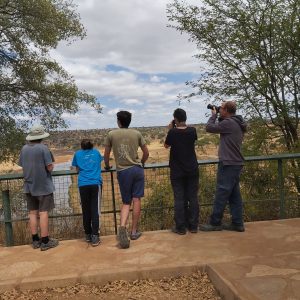

We stopped at a huge tourist complex.
Lotem and I watched as men carved a ‘totem pole’ out of ebony.
Ebony is a very dark dense
wood and very expensive. It takes 3 men to carve. One man strips the
lighter
outer bark from the log: the one in the picture does the carving, while
the
third polishes the wood. I had hoped to buy Tanzanite, not realizing
that it
was a very precious and expensive stone, found only in a certain area
of Tanzania.
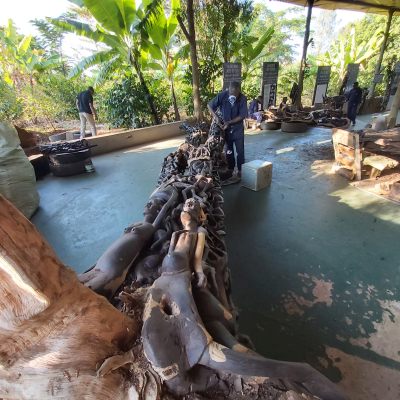 [
[
That day we saw a troop of Olive Baboons
sitting and eating the ripe sausages that had fallen from the sausage
tree Kigelia africana. Eitan and I love to
eat pizza in Netanya by a restaurant surrounded by sausage trees. We
always
make sure to park our car away from the trees; quite sure a falling
sausage
would dent our car, or us.
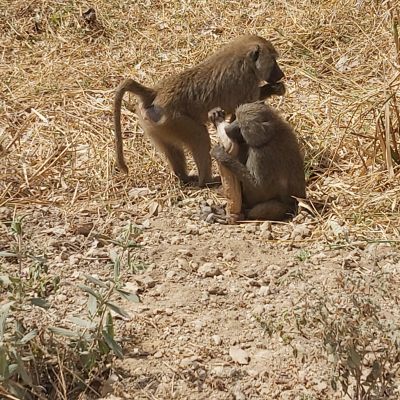
After lunch and stopping to look at
elephants and
buffalo we made the long
drive to Acacia Lodge in Ngorogoro. What a welcome we received, with
moist
towels and a drink served by the staff singing and dancing.
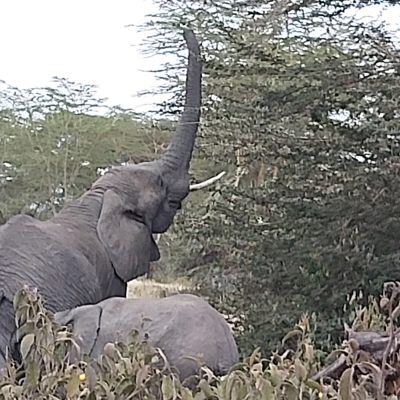
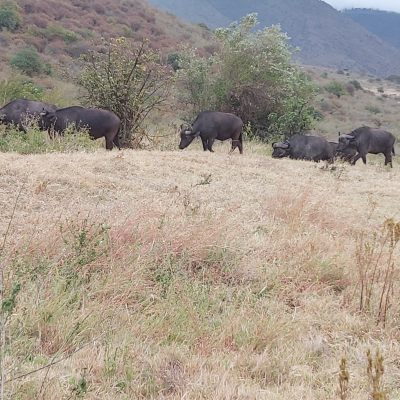
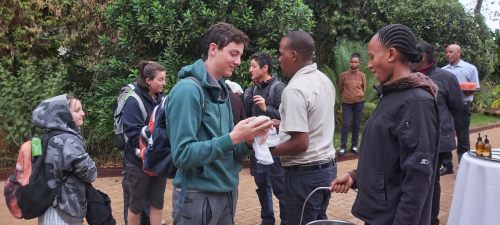
We were introduced to the staff, notably Martin our butler (!) who looked after our every need. After being lead to our rooms we quickly changed and went for a swim in the sweet water. Surprise – zucchini soup for supper!

Acacia Lodge was built by a local man
who made his money from growing onions.The lodge is surrounded by a
high wall
which
meant the Segolis could walk around at night and look for bush babies
and chameleons in the trees and they even saw a hedgehog.
Day
3 12th July
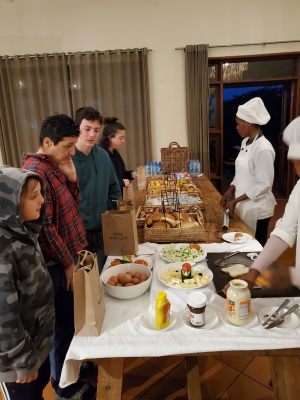
At breakfast we had to choose what we
wanted for a packed lunch. The
morning was cold and rainy. I was dressed
totally inappropriately and was cold the whole day. In
the early morning we saw young children
make their way to school, neatly dressed in school uniforms. The lucky
ones
were bussed to school; the poorer ones had to walk, often running to
school in
the rain.
We drove through thick mist blanketing the mountain forests, surprised to see that elephants had no trouble climbing the 1500 meter high slopes. We reached the Ngorongoro Conservation Area, a massive crater that was originally part of Serengeti and descended down to the crater bed. The ‘new’ animals we saw were hippo and flamingo. There is a salt lake in the center of the crater, but because of much rainfall the brine shrimp and algae were not easily accessed by the flamingos and most sought different feeding grounds. My favourite picture is of a ‘devil’ hippo. He had been feeding on the grass by the lake and got this scary face.
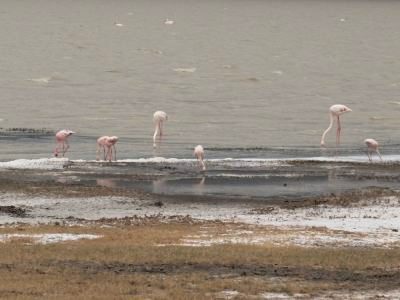
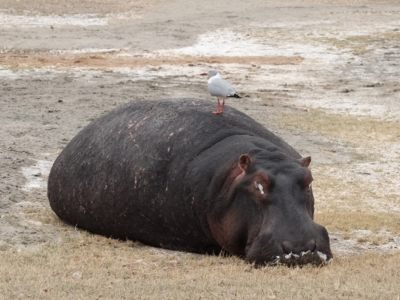
We stopped for lunch at Ngoitokitok springs picnic area with a bunch of hippos nestling not far from the lake area. This time it was brown hawks that were ready to swoop down and relieve us of our lunch with a marabou stork ungainly walking around and hoping for some scraps. It was bitterly cold
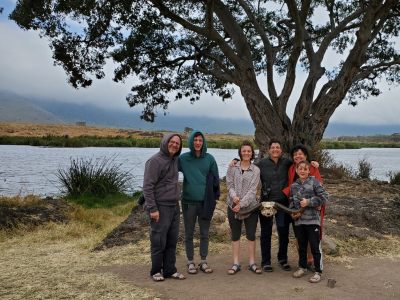
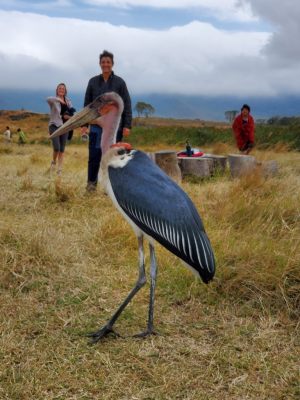
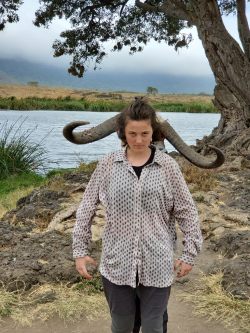
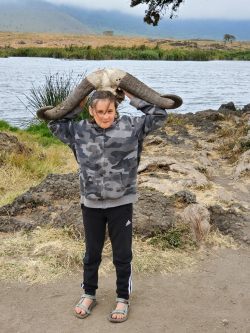

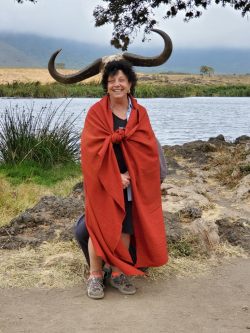
On our return to Acacia Lodge we were welcomed again by wet towels drinks and singing. We regrouped and were taken on a tour of the gardens at Acacia Lodge. They grow all their own fruit and vegetables and grow and process Arabica coffee that grows at 1500 m.
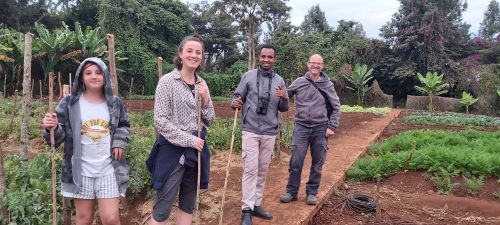
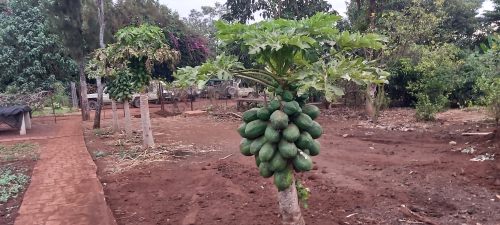
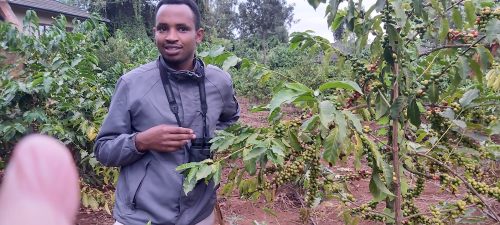
Among the
many coffee capsules that Eitan buys is one called robusta;
I learnt it
was
coffee that grows at low altitudes.
We sat in front of the warming fire
with
drinks and snacks until
we went for supper. Surprise
– zucchini soup again!
Day
4 13th July
After another early rise and hearty breakfast
we made our way to Serengeti in bright sunlight. We added topis,
warthogs and hartebeest
to our list of sighted animals in addition to numerous birds. One of
the
highlights was seeing a cheetah chase a Tomson’s gazelle and catch her
baby
without much effort.
During the day we saw huge numbers of
gnus, adults and babies, walk in single file as they migrated toward
the Mara
River in Serengeti, which they would cross, making their way to Masai
Mara in Kenya where food was plentiful.. The
young are about 5 months old.
Almost 2 million gnus, zebra and gazelle will cross the Mara River now.
It is
the dry season and grass is becoming scarce.
Once they cross they will rest and make their way to Kenya to
Masai
Mara where they will remain until about October. Njano said although
they are
in different areas they will all start at the same time to make the
treacherous
journey back to Serengeti when the river is in full flood and swarms of
crocodiles wait to attack.
As we made our way to Maniata Maasai
village we had a toilet stop from where we could see the Olduvai Gorge
in the
distance. Mary Leakey in 1959 discovered the earliest evidence of the
existence
of our human ancestors. Olduvai means wild sisal plants which we saw
frequently, used still to make ropes.
At the village we were greeted by the Maasai
and garlanded with beaded necklaces. Both men and woman danced in a weaving circle and we
joined in.
While
chanting various warriors would come forward and jump as high as they
could,
showing their strength and prowess as warriors. We were very proud of
Maayan’s
attempts which they appreciated. We then went to the school for
children between the ages of
3 and 6
and were impressed by their neat notebooks, arithmetic and ability to
sing
abcd etc.
(Zoe joined in).
A flat tire needed to be changed. While Njano struggled with it, Moran, Lotem and Zoe did some stomach presses, asking me to photograph them. Just a minute, just a minute I kept on calling long after taking the photo until they collapsed from tiredness and we from laughter.
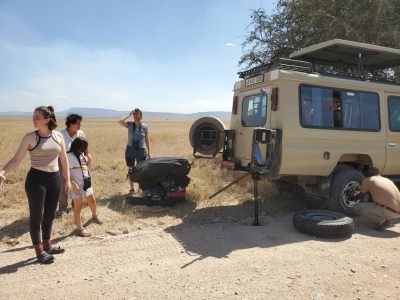
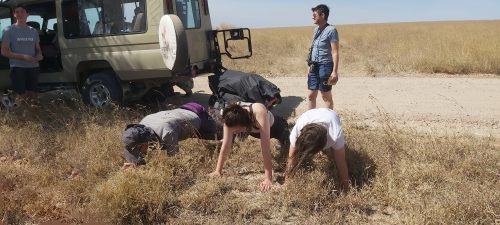
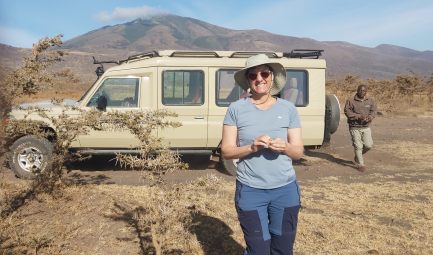
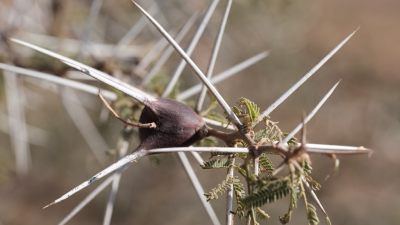
Just before 6.00pm, the time when people
are supposed to be out of the park, we arrived at Mbuzi Mawe Serena
tented
lodge. Again a place with no fences. This time we had two guards
escorting us
to and from the rooms - one with a kalatchnikov, the other with a sling
shot. Surprise - zucchini soup for supper.
Day 5 14th July
We were advised to wear long clothes
that were not black as it attracted tsetse flies. We saw special blue
material
hanging in trees all over Serengeti, meant to attract and sterilize the
flies. On our honeymoon Eitan and I went
to Tsavo Game Reserve, officially closed, but we found someone to take
us
around. At some point the car got stuck. Fully expecting the driver to
get out
and push we were surprised by his adamant refusal to leave the car as
he was
afraid of tsetse flies, leaving us no option but to get out and push...
and
pray.
Always in the distance we saw fires from
burning grass. It is to hasten growth of green shoots to feed the huge numbers of migrating animals and also to
kill the tsetse fly eggs laid in the grass.
We ate lunch in an area of short grass
(who wants a lion stalking us?). It gave Moran and Mikhal another opportunity
to search for insects
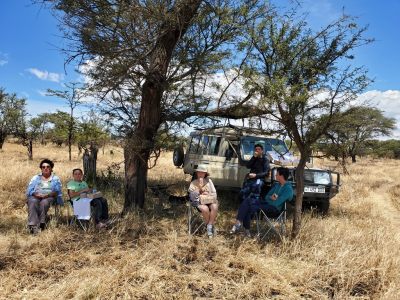
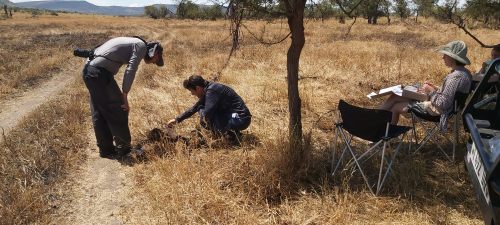
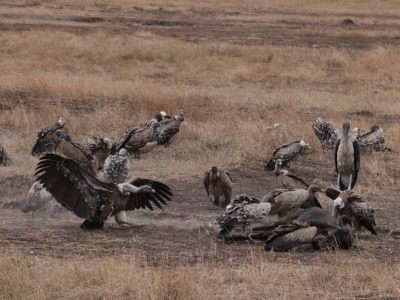
We
watched as an increasing number of vultures, griffon
and
lappet-faced vultures, and marabou storks gathered near the
carcass
of a gnu. Only a few of the strongest were eating while
any challengers
to the feasts were chased away; the storks
hovered by, waiting for
their chance to snatch a morsel.
Camp Zebra Kogatende is a temporary
tented camp erected only during the two migration seasons and so is
rather
basic but pleasing.
Although there was running water for the sink and toilet, before a shower we had to inform the men who would then fill containers by the showers with warm water. It reminded me of our days in Sinai when Eitan improvised a similar method for us to shower off the salt at the end of the day. The kitchen was quite a way away from the dining tent – they didn’t want any reason for animals to approach the tents too closely. But we did hear gnus, hyenas, zebras and even a lion during our two nights there.

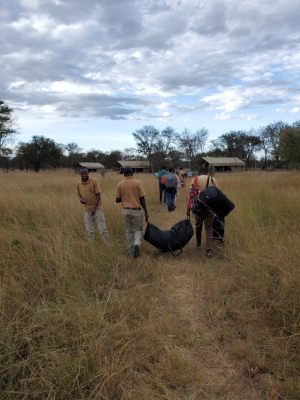
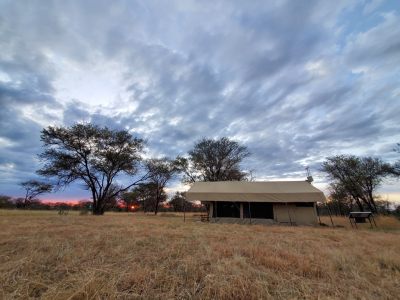
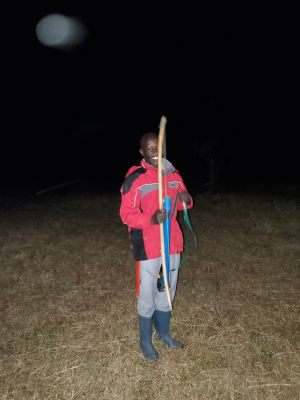 This time our guard escort was equipped with a bow and
arrow
This time our guard escort was equipped with a bow and
arrow
Day 6 15th July Camp Zebra
We woke early and admired
the spectacular sunrise
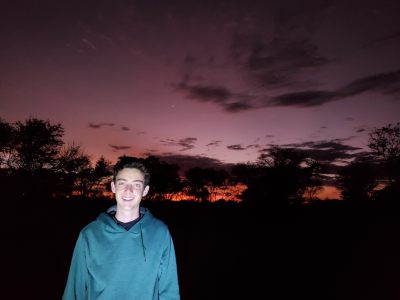
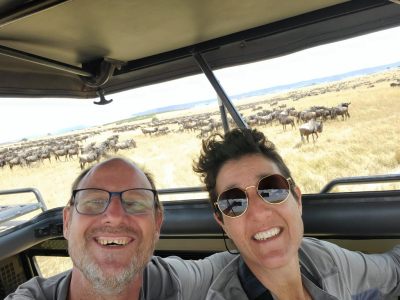
Njano assured us the wildebeest would not cross before 800am. We watched amazed at the thousands of gnus milling about on the plain above the river, as more and more gnus joined them. Suddenly great numbers started to run along the plain and we were frightened to miss their crossing. Njano assured us he was not moving as they might just come back. Which they did. Then suddenly it started. They didn’t choose the easiest way to get down to the water, sliding and falling on the sandy banks. The water is very low at this time of year and although the vast majority raced across the river, some were more relaxed and stopped to drink. We were horrified to see a group of young gnus race back into the water, but Njano assured us they were just looking for their families. After a long pause another group made the crossing, scrambling up the bank just in front of our vehicle. The huge plain that had been full of gnus earlier was now empty of animals. The dust subsided and the river returned to its slow flow until the next crossing.
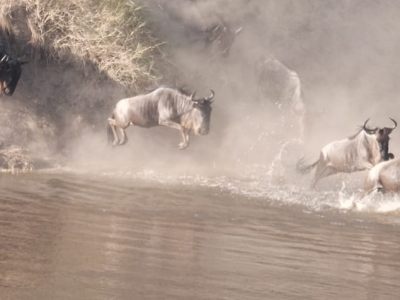
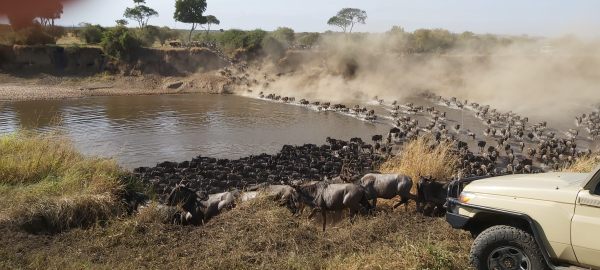
We did not see crocodiles in the water
nor any animals dying during the crossing, although a few were limping.
A great
disappointment for the vultures and marabou storks waiting nearby to
eat the
remains of a kill. One gnu did not move, injured I suppose, but we were
told
that until it died the vultures would not move in.
For the first time we would return to
the camp for lunch and remain there until the heat of the day had
abated. I lay
down trying to rest but my mind’s eye was full of the gnus crossing the
river.
After some twenty minutes I told Lotem, with whom I was sharing the
tent that
I couldn’t sleep with all the gnus in my head. She scoffed saying I was
snoring
almost immediately. Oh no, Lotem I replied, that was the gnus gnuing!
 In the afternoon we saw full-bellied
cheetahs lying in the grass.
In the afternoon we saw full-bellied
cheetahs lying in the grass.
The others had
seen a leopard
previously, I
had not and so we (=Njano) were on a hunt to spot a leopard. A gutted
Tomson’s
gazelle was in the branches of a tree; we stopped, remaining to look
for the
leopard. We were well rewarded when the leopard came into view and
subsequently
climbed the tree and lay
on a branch near his kill. It was a very warm day. Slowly we saw one
leg drop
down and then the other leg, on the other side of the branch, and then
a front
leg. Head down and the leopard, totally relaxed, fell asleep.
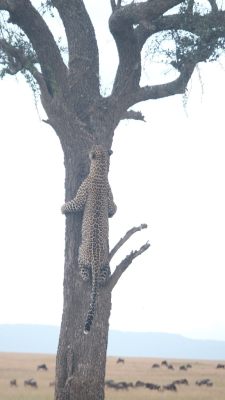

Late in the afternoon we did see
crocodiles in the river and did not know whether we saw two crocodiles
fighting
or one thrashing with a kill. 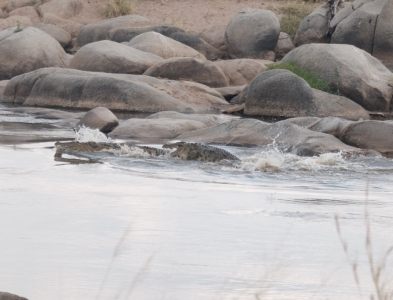
.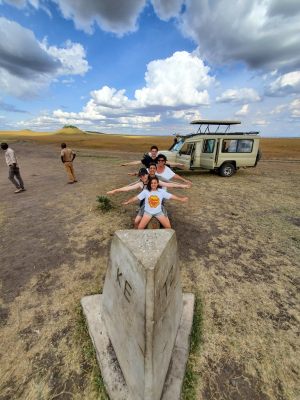
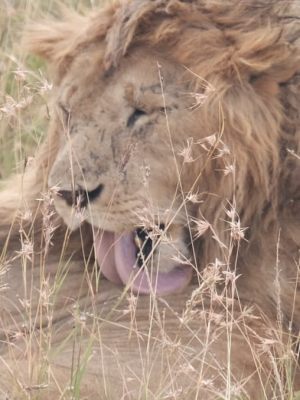
We returned to Camp Zebra.
Day
7 16th July
We were packed and ready to go after an
early breakfast with the hope of seeing another crossing before we
returned.
The gnus obliged and we saw 2 more crossings including a few zebra with
the
masses. One gnu lay dead
in the water
. 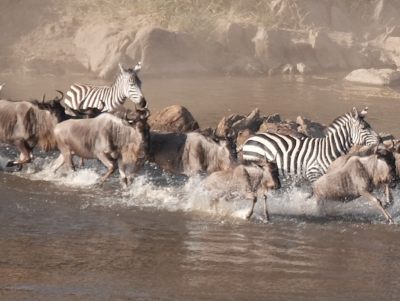
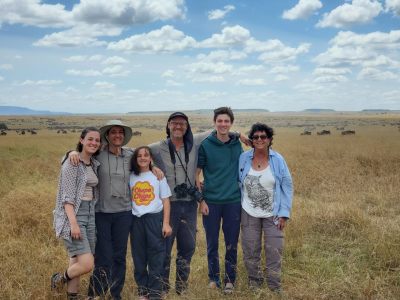
During our safari we saw over 50 lions,
5 cheetahs and 2 leopards, besides thousands of other animals. We saw
griffon
vultures and lappet faced vultures, hawks, eagles, flamingoes,
starlings,
rollers, various bustards, secretary birds, cranes and others I don’t
remember, I was very pleased. “Lots
of” it certainly was.
We drove to the local airport and were
surprised by the number of propeller planes landing and taking off. We
weren’t
the only people who wanted to avoid the difficult drive back. After
taking off from
Kilimanjaro airport we finally saw Mount Kilimanjaro rising 5,895
meters high,
with a little snow on its peak.
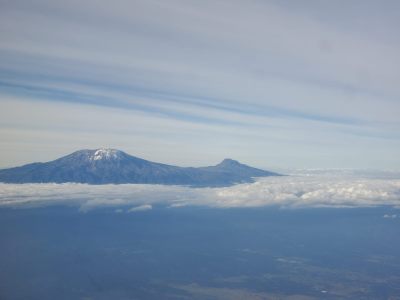
Again a stop at Addis airport and an
easy
flight home. We all agreed it was a most successful safari.
Click on the
picture for a short video clip
Many, many thanks to my amazing husband Eitan who with
patience and incredible skill spent
long hours combining and uploading what I wrote with my and Moran's
photos into a coherent whole, all the time while in charge of the
European Youth Bridge Championships.
Although I only included special pictures
following is a checklist of the animals we saw. The bird list is only
partial as I am not a bird watcher:
lion, cheetah, leopard, gnu, zebra, elephant, giraffe, buffalo, hippo,
crocodile, ostrich, Tomson's gazelle, Grants gazelle, hartebeest,
impala, topi, eland, waterbuck, reedbuck, dik dik, klipspringer, oribi,
hyrax, Vervet monkey, olive baboon, monngoose, hedgehog, bushbaby,
chameleon, griffon vuture, lappet-faced vulture, marabou stork, various
herons,
crested cranes, hawk, eagle, flamingo, egyptian geese,
guinea fowl
RETURN TO DOREEN and EITAN'S HOME PAGE
.